Philip Adolphe Klier
Philip Adolphe Klier (c.1845–1911), also known as Philip Klier, was a German photographer, whose existing photographs were taken in Burma during the British colonial period. He was born in Bremen, Northern Germany, and is considered as one of the earliest and most interesting photographers in Burma of this period.[1][2]
Philip Adolphe Klier | |
|---|---|
| Born | 1845, Bremen, German Confederation |
| Died | 1911 (aged 65–66) |
| Occupation | Photographer |
Life and work
.jpg)
After having emigrated from Germany to British Burma, Klier first settled in Moulmein (now Mawlamyine, Mon State) in 1865 and started to work as a watchmaker in a small community of German watchmakers, opticians and photographers. After 1880, Klier and his family moved to the capital Rangoon, where he set up his own studio and found better chances for selling his photographs. For the five years after 1885, Klier temporarily entered a partnership with J. Jackson, an established British photographer, but after that, he continued on his own.[1][3]
The wide range of his photographs document his strong interest in both colonial British as well as in Burmese life and culture.[2] Many of his photographs were printed as albumen prints, the most popular photographic printing technique of the late 19th century. As the technical possibilities of photography developed, so did his approach to presenting the subjects of his portraits: the two early portraits of a young English lady in the style of cabinet cards, taken around 1894 and archived at the National Portrait Gallery in London,[4] or the portrait of an unknown man archived next to his business card, attest to the portrait style of the late 1890s, and stand in stark contrast with his later portraits, such as the picture of a Burmese lady of 1907, with a blurred background and crisp details of her person, clothes or jewellery in the foreground.
Apart from photographic portraits of Europeans or street scenes of busy areas of Rangoon, Klier carefully staged and recorded portraits of Burmese people in traditional attire, like a princess and her following or a chief from the princely Shan States in eastern Burma shown below.
Klier also had a keen interest in everyday street scenes, documenting traditional musicians or audiences watching the popular Burmese puppet shows (Yoke thé) of those times. Other scenes show working life, for example elephants and their keepers at work in timber yards or paddy boats carrying rice. Klier also took photographs of famous buildings, like Burma's most important religious monument, the Shwedagon Pagoda[5] or the great mosque[6] in Rangoon. Other street scenes of colonial Rangoon include the famous Strand Hotel. For his approach, Klier's work was characterized as follows: "Klier had an eye for the unusual and many religious buildings which would have been ignored by another were fortunately immortalized by him.[7] Many of Klier's photographs have been archived and digitised by the National Archives in the United Kingdom.[8]
 Burmese couple in the 1890s
Burmese couple in the 1890s Burmese musicians at the Shwedagon Pagoda
Burmese musicians at the Shwedagon Pagoda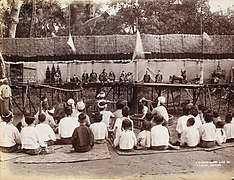 A traditional Burmese puppet show
A traditional Burmese puppet show Burmese monks and novices, 1907
Burmese monks and novices, 1907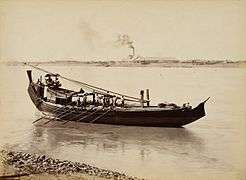 Detail of Burmese Paddy boat, 1907
Detail of Burmese Paddy boat, 1907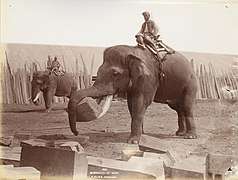 Elephants at work in Rangoon, 1907
Elephants at work in Rangoon, 1907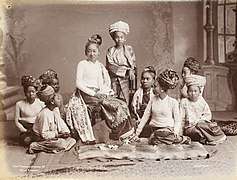 Shan princess and followers, 1907
Shan princess and followers, 1907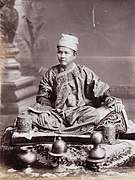 A Shan chief, sitting on a cusion
A Shan chief, sitting on a cusion A Burmese lady, 1907
A Burmese lady, 1907 A Burmese Lady, colour litho
A Burmese Lady, colour litho
References
- "A look into the life of one of Burma's earliest photographers". The Myanmar Times. 2019-01-22. Retrieved 2019-10-09.
- "Burmese days: the extraordinary photos of Philip Adolphe Klier". ITCHY FEET, ITCHY MIND. 2014-03-11. Retrieved 2019-10-09.
- See, for example, Johnson's photograph of a Burmese Minister in Court Dress.
- "Philip Adolphe Klier - National Portrait Gallery". www.npg.org.uk. Retrieved 2019-12-15.
- "Gold-Covered Stupa at Shwedagon Pagoda". Getty Images. Retrieved 2019-12-17.
- "The Mosque Rangoon". Getty Images. Retrieved 2019-12-17.
- Singer, Noel Francis (1993). Burmah: a photographic journey, 1855-1925, p.8. P. Kiscadale. ISBN 978-1-870838-26-9.
- Archives, The National. "The Discovery Service". discovery.nationalarchives.gov.uk. Retrieved 2019-12-16.
See also
| Wikimedia Commons has media related to Philip Adolphe Klier. |
- Sadan, Mandy. "The Historical Visual Economy of Photography in Burma." Bijdragen Tot De Taal-, Land- En Volkenkunde 170, no. 2/3 (2014): 281-312. www.jstor.org/stable/43817948.
- The Encyclopedia of Nineteenth Century Photography, p. 1317
- Collection of photographs by Philip Adolphe Klier on flickr.com
- John Falconer, British Library, A Biographical Dictionary of 19th Century Photographers in South and South-East Asia on Philip Adolphe Klier
other important photographers of the 19th century in Burma: